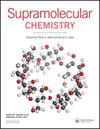β-环糊精对水中双酚S异构体的选择性识别
IF 2.6
4区 化学
Q3 CHEMISTRY, MULTIDISCIPLINARY
引用次数: 1
摘要
摘要:4,4′-二羟基二苯基砜和2,4′-二羟基二苯基砜(双酚S, BPS)两种异构体在溶液、气相和固态下均与β-CD形成包合物。通过一维和二维核磁共振实验研究了配合物4,4′-BPS@β-CD和2,4′-BPS@β-CD。ITC的量热研究表明,β-CD宿主对4,4′-BPS具有更强的亲和力,其4,4′-BPS/2,4′-BPS的选择性比为6.3。在气相中,CID MS实验表明,4,4′-BPS比同分异构体2,4′-BPS具有更高的逃离β-CD腔的动力学屏障。在固体状态下,4,4′-BPS@β-CD和2,4′-BPS@β-CD配合物形成由两个β-CD大环组成的头对头二聚体,每个β-CD含有一个BPS客体。β-CD的二聚体是通过氢键相互作用封闭的,氢键相互作用只涉及仲羟基。最后,对4,4′-BPS或2,4′-BPS与β-CD之间的包合物形成进行FT-IR、DSC和TGA分析。图形抽象本文章由计算机程序翻译,如有差异,请以英文原文为准。
Selective recognition of bisphenol S isomers in water by β-cyclodextrin
ABSTRACT The two isomers 4,4´-dihydroxydiphenyl sulphone and 2,4´-dihydroxydiphenyl sulphone (bisphenol S, BPS) form inclusion complexes with β-CD in solution, in the gas phase, and in the solid state. The complexes 4,4´-BPS@β-CD and 2,4´-BPS@β-CD were studied in solution by 1D and 2D NMR experiments. Calorimetric investigation by ITC evidenced that the β-CD host shows a greater affinity for 4,4´-BPS, with a 4,4´-BPS/2,4´-BPS selectivity ratio of 6.3. In the gas phase, CID MS experiments indicate that 4,4´-BPS has a higher kinetic barrier to escape from the β-CD cavity than the isomeric 2,4´-BPS. In the solid state, the 4,4´-BPS@β-CD and 2,4´-BPS@β-CD complexes form head-to-head dimers constituted by two β-CD macrocycles, with each β-CD hosting one BPS guest. The dimers of β-CD are sealed by H-bonding interactions involving exclusively the secondary OH groups. Finally, the formation of inclusion complexes between 4,4´-BPS or 2,4´-BPS and β-CD was also followed by FT-IR, DSC, and TGA analysis. Graphical abstract
求助全文
通过发布文献求助,成功后即可免费获取论文全文。
去求助
来源期刊

Supramolecular Chemistry
化学-化学综合
CiteScore
3.60
自引率
3.00%
发文量
5
审稿时长
2.7 months
期刊介绍:
Supramolecular Chemistry welcomes manuscripts from the fields and sub-disciplines related to supramolecular chemistry and non-covalent interactions. From host-guest chemistry, self-assembly and systems chemistry, through materials chemistry and biochemical systems, we interpret supramolecular chemistry in the broadest possible sense. Interdisciplinary manuscripts are particularly encouraged. Manuscript types include: high priority communications; full papers; reviews, and; Methods papers, techniques tutorials highlighting procedures and technologies that are important to the field. We aim to publish papers in a timely fashion and as soon as a paper has been accepted and typeset it will be published in electronic form on the Latest articles section of the website. The two most important review criteria are that the paper presents high-quality work that fits generally into the broad spectrum of activities in the supramolecular chemistry field. Under normal circumstances, Supramolecular Chemistry does not consider manuscripts that would be more suitable in a highly specialized journal. This includes, but is not limited to, those based mostly or exclusively on topics such as solid state/X-ray structures, computational chemistry, or electrochemistry. .
The two most important review criteria are that the paper presents high-quality work that fits generally into the broad spectrum of activities in the supramolecular chemistry field.
 求助内容:
求助内容: 应助结果提醒方式:
应助结果提醒方式:


